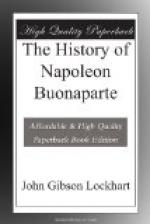To give the details of the sixth campaign, which now commenced, would be to repeat the story which has been already five times told. The Archduke, fettered by the Aulic Council of Vienna, saw himself compelled to execute a plan which he had discrimination enough to condemn. The Austrian army once more commenced operations on a double basis—one great division on the Tyrolese frontier, and a greater under the Archduke himself on the Friulese; and Napoleon—who had, even when acting on the defensive, been able, by the vivacity of his movements, to assume the superiority on whatever point he chose to select—was not likely to strike his blows with less skill and vigour, now that his numbers, and the acquiescence of Italy behind him, permitted him to assume the offensive.
Buonaparte found the Archduke posted behind the river Tagliamento, in front of the rugged Carinthian mountains, which guard the passage in that quarter from Italy to Germany. Detaching Massena to the Piave, where the Austrian division of Lusignan were in observation, he himself determined to charge the Archduke in front. Massena was successful in driving Lusignan before him as far as Belluno, (where a rear guard of 500 surrendered,) and thus turned the Austrian flank. Buonaparte then attempted and effected the passage of the Tagliamento. After a great and formal display of his forces, which was met by similar demonstrations on the Austrian side of the river, he suddenly broke up his line and retreated. The Archduke, knowing that the French had been marching all the night before, concluded that the general wished to defer the battle till another day; and in like manner withdrew to his camp. About two hours after Napoleon rushed with his whole army, who had merely lain down in ranks, upon the margin of the Tagliamento, no longer adequately guarded—and had forded the stream ere the Austrian line of battle could be formed. In the action which followed (March 12) the troops of the Archduke displayed much gallantry, but every effort to dislodge Napoleon failed; at length retreat was judged necessary. The French followed hard behind. They stormed Gradisca, where they made 5000 prisoners; and—the Archduke pursuing his retreat—occupied in the course of a few days Trieste, Fiume, and every stronghold in Carinthia. In the course of a campaign of twenty days, the Austrians fought Buonaparte ten times, but the overthrow on the Tagliamento was never recovered; and the Archduke, after defending Styria inch by inch as he had Carinthia, at length adopted the resolution of reaching Vienna by forced marches, there to gather round him whatever force the loyalty of his nation could muster, and make a last stand beneath the walls of the capital.




